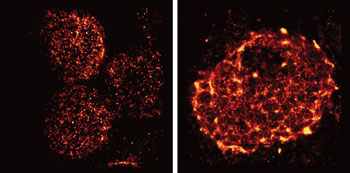Advanced Techniques Enable Mapping of Immune T-cell Surface Membranes
By LabMedica International staff writers
Posted on 28 Jun 2016
Advanced high-resolution (super-resolution) microscopy was used to map the surface membranes of immune T-cells before, during, and following activation by antigen-presenting cells.Posted on 28 Jun 2016
T-cells become activated when T-cell receptors (TCRs) recognize agonist peptides bound to major histocompatibility complex molecules on antigen-presenting cells. T-cell activation critically relies on the spatiotemporal arrangements of TCRs on the plasma membrane. However, the molecular organizations of TCRs on lymph node-resident T-cells have not yet been determined, owing to microscope techniques being restricted to the diffraction limit of light.

Image: Super-resolution imaging was used to capture the rearrangement of T-cell receptors from nanometer-scale protein islands (left) to micrometer-scale microclusters (right) after T-cell activation in mouse lymph nodes (Photo courtesy of the Salk Institute for Biological Studies).
In a new study, investigators at the Salk Institute for Biological Studies (La Jolla, CA, USA) used two advanced "super-resolution" microscope techniques to map the T-cell surface membrane.
The first method, structured illumination microscopy (SIM) is a wide field technique in which a grid pattern is generated through interference of diffraction orders and superimposed on the specimen while capturing images. The grid pattern is shifted or rotated in steps between the capture of each image set. Following processing with a specialized algorithm, high-frequency information can be extracted from the raw data to produce a reconstructed image having a lateral resolution approximately twice that of diffraction-limited instruments and an axial resolution ranging between 150 and 300 nanometers.
The second method, dSTORM (direct stochastic optical reconstruction microscopy), is more sensitive with resolution of approximately 50 nanometers. This method utilizes the photoswitching of a single fluorophore. In dSTORM, fluorophores are embedded in an oxidizing and reducing buffer system (ROXS) and fluorescence is excited. Sometimes, stochastically, the fluorophore will enter a triplet or some other dark state, which is sensitive to the oxidation state of the buffer. As the molecules return stochastically they can be excited to fluoresce so that single molecule positions can be recorded.
Results of the study were published in the June 14, 2016, online edition of the journal Proceedings of the [U.S.] National Academy of Sciences. The investigators observed nanometer-scale plasma membrane domains, known as protein islands, on naïve T-cells. These protein islands were enriched within micrometer-sized surface areas that they called territories. In vivo T-cell activation caused the TCR territories to contract, leading to the coalescence of protein islands and formation of stable TCR microclusters.
"We had seen these receptors cluster and reposition in cultured cells that were artificially stimulated in the lab, but we have never seen their natural arrangements in lymph nodes until now," said senior author Dr. Björn Lillemeier, associate professor n the Nomis Center for Immunobiology and Microbial Pathogenesis at the Salk Institute for Biological Studies.
Related Links:
Salk Institute for Biological Studies














